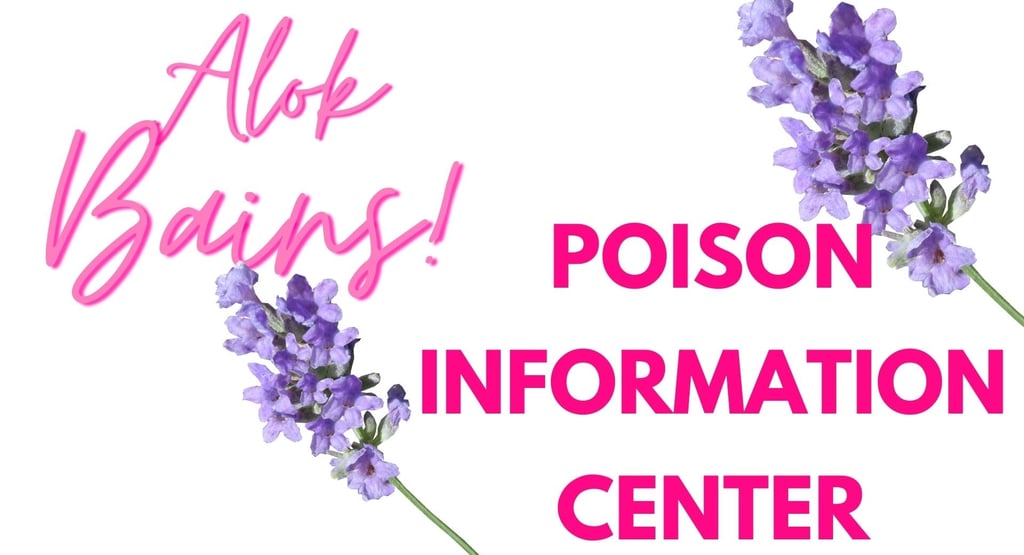Poison Information Center PIC
Poison Information Center (PIC) or Poison Control Center (PCC) Definition Goal and Procedure
HOSPITAL PHARMACY
Alok Bains
5/10/20233 min read


Poison Information Centre
Definition Goal and Procedure
Compiled by Alok Bains
Introduction
Any substance that causes harmful effects or death after its ingestion, breathing, injection or absorption from skin, mucous membrane or eyes is called poison. Poisoning may be accidental or intentional. It may also be due to an overdose of medicines, medication error or bite/sting by a snake, spider, bee, wrap, etc. Poisoning is a common cause of admission in hospital emergency or accident wards. Poisoning is a time-dependent emergency. It requires the services of a specialist to diagnose and treat. Health professionals could not be expected to know about the toxicity of every chemical substance and product.
WHO implemented International Health Regulations (2005) with the aim "to prevent, protect against, and control international spread of disease. Poison centres have an important role in the implementation of International Health Regulations. A poison centre is called a poison information centre (PIC) or poison control centre (PCC). Most of the developed countries and developing countries have established Poison Information Centres (PIC). In India, the first Poison Information Centre was established in 1995 in the pharmacology department at All India Institute of Medical Sciences, New Delhi (AIIMS, New Delhi).
Definition
“Poison Information Centre (PIC) is a specialized unit to provide information on prevention, early diagnosis, and treatment of poisoning along with chemical hazard management”. The structure and functions of the Poison Information Centre vary from country to country. The staff of the PIC is trained healthcare professionals to diagnose and treat poisoning. PIC has advanced technology for quick and accurate identification of poisoning.
Goal
The Primary goal of PIC is to reduce morbidity and mortality due to poisoning and to improve the quality of life of patients.
Functions
PIC performs the following functions to achieve its goal.
The main function of PIC is to advise and/or assist to prevent, diagnose and manage poisoning.
Risk assessment and exposure assessment of poisoning.
In addition, PIC may also include the following activities
Toxicology analytical laboratories and/or clinical treatment units,
Analytical toxicology support, research, education and training,
Emergency poison information and clinical services,
Monitoring adverse effects of the drugs and consumer products,
Handling problems with abusive substances, and
Management of chemical disaster.
After including all these activities, Poison Information Centre may be named as toxicovigilance or toxicosurveillance.
Poison Information Centre is a part of the medical facility to provide immediate free and expert treatment advice and assistance on the telephone. They answer all quarries related to personal care, household products, pesticides, plants, bites and stings, food poisoning, alcohol, gases, fumes etc, Maximum poison quarries are managed by telephone conversation. This reduces the need for costly emergency services and doctor visits.
Procedure
PIC gathers data from various resources to perform its functions. These information resources are categorised into the following three categories
Primary resources: Journals of medicine and toxicology are primary resources to collect current development in poison and toxic substances/products. Examples are the British Journal of Industrial Medicines, Human and experimental toxicology, the American Journal of Industrial Medicines, Biochemical Pharmacology, etc. PIC develops educational materials, posters, booklets and leaflets by using these resources and also acts as primary resources. These guide patients and the general public about pesticides, chemicals, safe storage of medicines, household products, etc.
Secondary resources: Several Governments develop their own database for poisonous products in their countries. This database is a secondary resource for information to be used in poisoning. If this database is not available then online available data from various websites are used as secondary resources. Such as Toxbase, Toxicom, Toxine, Toxnet, Intox, Haypertox, Poisondex, etc.
Tertiary resources: Reference and textbooks of medicines, pharmacology, toxicology, medical dictionaries, pharmacopoeia, etc are tertiary resources to collect information in PIC.
Poison Information Centre is assessable through a toll-free number, 24 hours a day, seven days a week, and 365 days a year.
Advantages:
Reduction in overall medical expenditure on patients,
Optimum utilization of space and facilities in hospitals,
Speedy recovery from the poisoning,
Improved quality of patient life suffering from poisoning,
Reduction in work-load of medical practitioners,
Round o Clock services to sufferers,
East and quick access to information,
